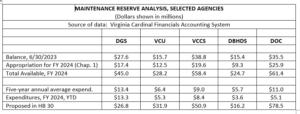 by Dick Hall-Sizemore
by Dick Hall-Sizemore
As staff members of the General Assembly start looking to “find” money in Gov. Youngkin’s proposed budget bill that can be used to fund priorities of their committee members (and they will be looking—that is a major part of their jobs during the Session), a good place to look would be capital maintenance reserve. There is at least $200 million in that budget item that could be taken without adversely affecting any of the agencies involved.
As defined by the Dept. of Planning and Budget (DPB) in its reporting instructions to agencies, a maintenance reserve (MR) project is “a major repair or replacement to plant, property, or equipment that is intended to extend its useful life.” A typical MR project would be repair or replacement of built-in equipment such as in HVAC systems; repair or replacement of building or plant components such as roofs or windows; and repair of existing utility systems such as steam lines or water systems.
The cost for an MR project must exceed $25,000 but be no more than $2.0 million for a non-roof replacement project and no more than $4.0 million for a roof replacement. DPB may grant exceptions to these dollar amounts and agencies must submit annual reports to DPB on MR expenditures.
Rather than require agencies to submit separate requests for these projects, a lump sum appropriation for MR is provided in the capital central appropriations portion of the budget bill. Language in the item provides the allocation of that amount among agencies, along with other conditions. Gov. Youngkin’s proposed budget would provide $404 million for MR for the upcoming biennium.
In past years, the allocations to individual agencies were based on the number of square feet in buildings owned by the agencies, with allowances made for newly-constructed or refurbished buildings. The method used for the allocation in the proposed budget bill is unknown.
In examining agencies’ utilization of MR funding, a key factor needs to be kept in mind. Unlike operating appropriations, year-end balances in capital projects are required to be re-appropriated for the next fiscal year, unless the project is completed. Therefore, what MR funding an agency does not spend in a fiscal year is carried forward into the next year.
For this analysis, the major premise was: if an agency consistently does not spend all its MR appropriation, thereby building up a sizable balance, it should not continue to receive additional appropriations until it spends what it has.
In comparing the amounts of MR funding available to agencies with their historical spending patterns, the following criterion was used: if an agency did not receive any MR allocation for the next biennium, would it have enough MR balance to get it through three fiscal years (FY 2024, FY 2025, and FY 2026), based on its most recent five-year average annual expenditure?
It was determined that, out of the agencies with the largest MR allocations in the proposed budget bill, five currently have sufficient MR appropriation to enable them to spend at, or above, their most recent annual rates through FY 2026 without receiving any additional appropriation for the next biennium.
It needs to be stressed that this conclusion does not reflect the actual need for MR funding. Each agency likely could justify on paper its need for the additional appropriations at issue and, possibly, for even more than is being proposed. However, they have, in recent years, shown that they are incapable, for whatever reasons, of spending the appropriations that they have been provided, thereby building up sizable balances. (Actually, these low rates of spending stretch back further than five years.)
The agencies and institutions identified were:
- Department of General Services (DGS)
- Virginia Commonwealth University (VCU)
- Virginia Community College System (VCCS)
- Department of Behavioral Health and Developmental Services (DBHDS)
- Department of Corrections (DOC)
The table below provides the details. Under each agency, the data in the first row show the amount of the MR balance on June 30, 2023, that was re-appropriated and carried forward into the current fiscal year. The next row is the agency’s allocation, and subsequent appropriation, for FY 2024 in the Appropriation Act enacted in September 2023 (Chap. 1). The next row is the total resulting MR appropriation for the current fiscal year. The fourth row is the agency’s average annual MR expenditure for the preceding five years. Next follows the amount spent so far this fiscal year for MR. The final row shows the agency’s allocation for the biennium in the Governor’s proposed, which, if enacted by the legislature, would be added to any balance on June 30, 2024.

The most extreme of these agencies can serve as an illustration of the conclusions of this report. At the beginning of this fiscal year, DOC had an appropriation of $61.4 million for MR. If it did not receive any additional appropriation for the 2024-2026 biennium, it could spend $15 million annually for three fiscal years (2024, 2025, and 2026), 36 percent higher than its most recent average annual expenditure, and still have a balance of $16 million on June 30, 2026. In fact, it would have to spend almost twice as much annually than it has spent in recent years to use up that $61.4 million balance by the end of FY 2026. It is noteworthy that, during a little more than the first half of this fiscal year, DOC has spent only $5.1 million of its MR balance. A similar analysis is applicable to each of the other agencies or institutions.
The total amount of MR funding proposed by the Governor in his budget for these five agencies is $204.3 million. The General Assembly could reduce the total amount proposed for MR by this amount and drop those agencies from the allocation list without impeding their MR efforts.
This is one-time funding; therefore, the legislature would be limited in how the “found” money could be used. One possible use could be continuation of the funding provided in this year’s Appropriation Act to address learning loss in K-12, which the Governor did not include in his budget bill (more on that in a future article).

Leave a Reply
You must be logged in to post a comment.